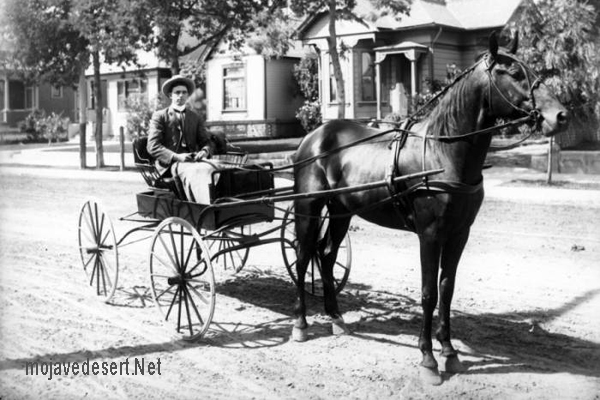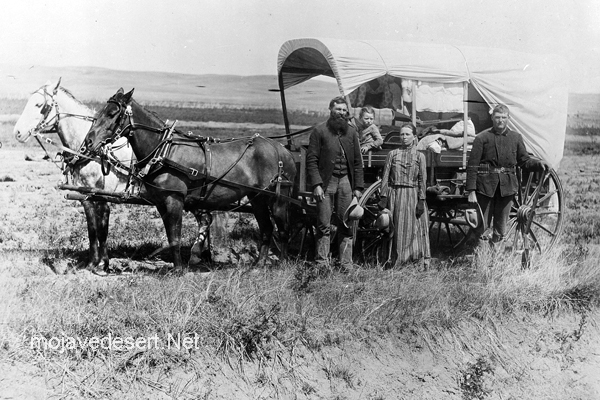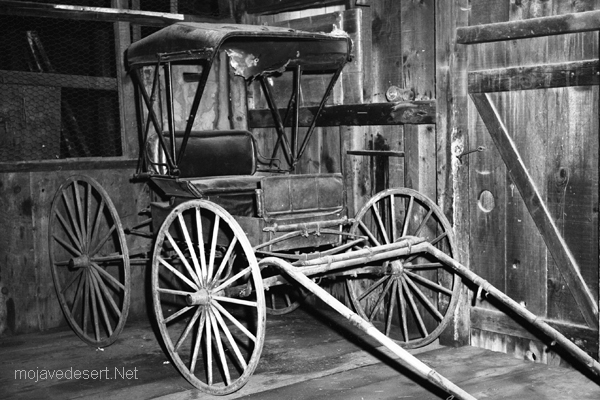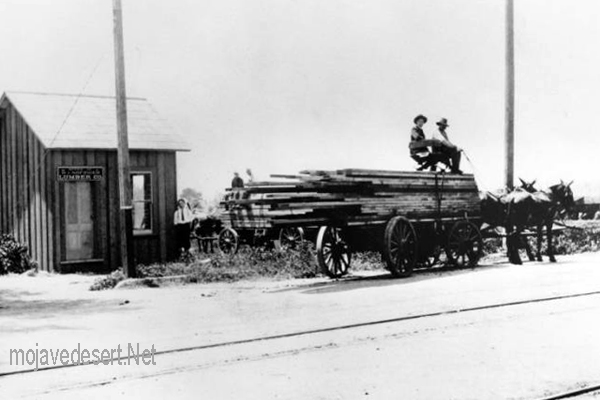Wagons, Carriages, & Carts

Man in cart

Mahta 11-passenger stage

Buckboard

Covered wagon

Granny Meyer's buggy

Lumber wagon

Two horse carriage
| Digital-Desert : Mojave Desert | Visit us on Facebook -- Desert Gazette -- Desert Link |
| Intro:: Nature:: Map:: Points of Interest:: Roads & Trails:: People & History:: Ghosts & Gold:: Communities:: BLOG:: Weather:: :?:: glossary |
Historic Roads & Trails
Wagons, Carriages, & Carts Man in cart  Mahta 11-passenger stage  Buckboard  Covered wagon  Granny Meyer's buggy  Lumber wagon  Two horse carriage |
Wagons, Carriages, & Carts of the Old WestDuring the Old West era in the 19th century, various types of wagons, carriages, and carts played crucial roles in transportation, trade, and settlement. These vehicles were essential for carrying people, goods, and supplies across the vast and often challenging landscapes of the American West. Here are some of the notable types:Conestoga Wagon:Often associated with the pioneer days and westward expansion, the Conestoga wagon was a large, sturdy, and broad-wheeled wagon designed to transport heavy freight. It had a distinctive curved bottom to prevent cargo from shifting during movement.Prairie Schooner:Similar to the Conestoga wagon but smaller, the Prairie Schooner was a covered wagon commonly used by pioneers and settlers for westward migration. Its canvas cover provided protection against the elements.Stagecoach:Stagecoaches were a vital means of passenger transportation and mail delivery. They were typically robust, enclosed vehicles with four to six horses. Stagecoaches played a significant role in connecting remote towns and cities.Buckboard:The buckboard was a simple, lightweight wagon with a springy board suspended across the axles. It was commonly used for short-distance transportation and could navigate rough terrain more easily than larger wagons.Chuckwagon:Chuckwagons were mobile kitchens used on cattle drives and during trailblazing. They were equipped with storage for food supplies, a cook stove, and other essentials. Chuckwagons played a crucial role in feeding cowboys on the trail.Covered Wagon:The covered wagon was a broad category that included various styles of wagons with protective covers. They were used for transporting families, supplies, and personal belongings during westward expansion.Gig:A gig was a small, two-wheeled carriage often used for personal transportation. It was lightweight and designed for speed, making it a popular choice for short-distance travel.Spring Wagon:Similar to a covered wagon but smaller, the spring wagon featured a spring suspension system to provide a smoother ride. It was often used for personal transportation and light hauling.Handcart:Handcarts were simple carts with two wheels, pushed or pulled by hand. They were used for transporting goods in smaller quantities and were especially common in mining towns. These wagons, carriages, and carts were essential for the survival and development of the Old West. They facilitated trade, transportation, and migration, contributing to the expansion and settlement of the American frontier.StagecoachesWheelwrights & Blacksmiths |
| Intro:: Nature:: Map:: Points of Interest:: Roads & Trails:: People & History:: Ghosts & Gold:: Communities:: BLOG:: Weather:: :?:: glossary |
|
Country Life Realty Wrightwood, Ca. |
Mountain Hardware Wrightwood, Ca. |
Canyon Cartography |
DesertLink Links to Desert Museums |
Grizzly Cafe Family Dining |

|
Abraxas Engineering privacy |
These items are historical in scope and are intended for educational purposes only; they are not meant as an aid for travel planning. Copyright ©Walter Feller. 1995-2023 - All rights reserved. |